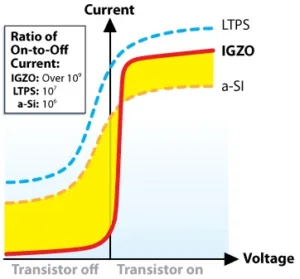A hat tip to the OLED Association for reporting a talk at IMID by Lee Sang-un of Yuanta Securities who has said that a new development may be needed for backplanes for AR/VR displays. One of the key requirements is that the display needs to have a very high pixel density, so the transistors need to be small, which favours LTPS technology. However, LTPS has a, relatively, higher level of leakage current, so it can be challenging to make really black pixels in a VR headset.
The good black can be achieved by using an Oxide transistor, such as IGZO.
Backplane current for different transistor materials. Image:Android Authority
Lee has suggested that a kind of hybrid transistor might be the answer and calls this approach Low Temperature Polysilcon and Oxide, or LTPO, with LTPS supplying the switching transistor, and IGZO the drive transistor. Lee is reported to have said that the technology might already be in use in displays for the Apple Watch or some iPads.
Yuanta is reported to have forecast that some companies are working on developing this technology into their fabs and the details are in the table below.

One of the barriers to adoption is cost. There seem to be no savings that can be made with special equipment needed for each type of transistor, so the cost might be 2.5X the cost of amorphous silicon (A-si), which is a combination of 1.5X of A-si for Oxides and 2X for LTPS.
Analyst Comment
At the moment, the key application that could support the cost of LTPO is probably VR. For large area panels, even where they can be made with good enough uniformity, even LTPS is just too expensive, let alone a process that cost even more. (BR)

